Photo Album: The Decorative Arts of Iberia, May 2015

The Decorative Arts of Iberia, May 2015
73 images
Hispanic-art historian Gijs van Hensbergen guided thirteen participants for thirteen days through the textile arts of Spain and Portugal, with unique access to works of art, personal guided tours with curators and meetings with directors.
- Mughal carpet fragment, Kashmir or Lahore, India, circa 1650. Pashmina pile on a silk foundation, 1.40 x 3.20 m (4′ 7″ x 10′ 6″). Calouste Gulbenkian Foundation, Lisbon, inv. T60, acquired by Calouste Gulbenkian from Georges Demotte in Paris in 1922
- Indian cotton chasuble made for the Portuguese Catholic church, hand drawn using dyes, mordants and resists, 18th century. Museu Nacional de Arte Antiga, Lisbon
- Mudejar ceiling, Museo Arqueológico Nacional, Madrid
- Zamora Pyxis, ivory, 353 after Hijra (964), Museo Arqueológico Nacional, Madrid
- The Lady of Elche, Museo Arqueológico Nacional, Madrid
- Roman mosaics, Museo Arqueológico Nacional, Madrid
- Roman mosaic (detail), limestone, 4th century, Museo Arqueológico Nacional, Madrid
- Triptych of the Coronation of the Virgin (detail), Marcellus Coffermans, 16th century, Antwerp, Museo Arqueológico Nacional, Madrid
- Gijs van Hensbergen leads the HALI Tour group through Madrid
- The HALI Tour group outside the Palacio Royale de Madrid
- Palacio Royale de Madrid
- Carpets made at Real Fabrica, Palacio Royale de Madrid
- A close up look at tapestries in the Patrimonio Nacional Collection in the underground storerooms, Palacio Royale de Madrid
- Silk weaving on the loom during strike action at Real Fabrica, Madrid
- Weaving on the loom during strike action at Real Fabrica, Madrid
- Spanish embroideries in the archives at Museo de las Artes Decorativas, Madrid
- Alpujarra rug with inscription, linen, Museo de las Artes Decorativas, Madrid
- Alpujarra rug (detail), linen, Museo de las Artes Decorativas, Madrid
- Tiles from a manor house kitchen in Valencia, 18th century, Museo de las Artes Decorativas, Madrid
- Tiles from a manor house kitchen in Valencia, 18th century, Museo de las Artes Decorativas, Madrid
- Cristina Partearroyo, Director of the Instituto de Valencia de Don Juan shows the single knot structure visible on the reverse of a 15th century Spanish Mudéjar ‘Armorial’ carpet
- Mudéjar ‘Armorial’ carpet, circa 1482, 1.91 x 3.82 m (6′ 3″ x 12′ 6″). Instituto de Valencia de Don Juan, Madrid, no.3.859
- ‘Alcaraz’ rug with gothic design, Spain, circa 1500, 1.28 x 1.99 m (4′ 2″ x 6′ 6″). Instituto de Valencia de Don Juan, Madrid, no. 3.860
- Hispano-Islamic tapestry fragment, silk and gold thread, 10th century, Andalusia, Instituto de Valencia de Don Juan, Madrid
- Rabat rugs furnish the living quarters of Guillermo Joaquín de Osma y Scull, diplomat, archeologist and founder of the Instituto de Valencia de Don Juan, Madrid
- Instituto de Valencia de Don Juan, Madrid
- Majolica ceramics, Instituto de Valencia de Don Juan, Madrid
- Nasrid ‘Alhambra’ textile fragment with infinite knots and horizontal stripes, Granada, 14th century. Silk lampas, 0.41 x 1.04 m (1′ 4″ x 3 ‘5″), Museo Lázaro Galdiano, Madrid, no. 1694
- Embroidery (detail), 17th – 18th entury, Chefchaouen, Morocco, Museo Lázaro Galdiano, Madrid
- Heather Ecker welcomes the HALI Tour group to a reception and tour of the Factum Arte workshops, Madrid
- Director, Adam Lowe explains the latest technological inventions being developed in the Factum Arte workshops, Madrid
- Director, Adam Lowe explains the latest technological inventions being developed in the Factum Arte workshops, Madrid
- Special exhibition of contemporary tapestries by Grayson Perry, Rachid Koraichi and Carlos Garaicoa at the Factum Arte workshops, Madrid
- Veil of Hisham II (r. 976-1013), Spain, Cordoba or Almeria, Spanish Umayyad period, 976-1013. From the Church of Santa Maria del Rivero of San Esteban de Gormaz, province of Soria. Taquete with inwoven tapestry weave; silk, linen, gold thread; 0.40 x 1.10 m (1′ 4″ x 3′ 8″). © Reproducción, Real Academia de la Historia, 292
- HALI Tour group, Toledo
- Stucco decoration, Synagoga del Tránsito, Toledo
- Indian Mughal tent with original interior panels dating to 1535, Museo del Ejército, Toledo
- ‘The Disrobing of Christ’ or ‘El Expolio’, El Greco, Sacristy of the Cathedral, Toledo
- A carpet sculpted from inlaid marble, Cathedral, Toledo
- Tapestry of the Astrolabes ‘Motions of the Universe’ (detail), Flemish tapestry, Tournai, circa 1450–1500. Wool and silk, 4.15 x 8.00 m (13′ 9″ x 26′ 3″). Colegio de Infantes Museum of Tapestries and Textiles of Toledo Cathedral.
- Tapestry of the Astrolabes ‘Motions of the Universe’ (detail), Colegio de Infantes Museum of Tapestries and Textiles of Toledo Cathedral.
- Tapestry of the Astrolabes ‘Motions of the Universe’ (detail), Colegio de Infantes Museum of Tapestries and Textiles of Toledo Cathedral.
- Standard of Sultan Abu Sa’id ‘Uthman (r. 1310 – 1331) and a medieval heraldic silk cope. Colegio de Infantes Museum of Tapestries and Textiles of Toledo Cathedral.
- ‘The Conquest of Arzila and Tangier’ tapestry series (detail), Collegiate Church, Pastrana
- ‘The Conquest of Arzila and Tangier’ tapestry series (detail), Collegiate Church, Pastrana
- Hanging houses of Cuenca
- Cuenca
- Cathedral, Cuenca
- Cuenca carpets in Cuenca Cathedral
- Cuenca carpets in Cuenca Cathedral
- Stonework, Cuenca Cathedral
- ‘Trojan War’ tapestry series (detail), 15th century, Cathedral, Zamora
- ‘Trojan War’ tapestry series (detail), 15th century, Cathedral, Zamora
- Cathedral, Burgos
- Cathedral spires and city gate, Burgos
- Burgos Cathedral
- Monasterio de Santa Maria la Real de Huelgas, Burgos
- Banner of Las Navas de Tolosa, Almeria, Spain, Almohad period (1212–50). Tapestry weave, silk and gold thread, 2.20 x 3.30 m (7′ 3″ x 10′ 10″). Museo de Telas Medievales, Monasterio de Santa Maria la Real de Huelgas, Burgos, 00652193
- Pillow cover, from the tomb of Queen Berengaria (d. 1246), Spain, Almeria?, pre-1246. Plain weave with inwoven tapestry weave; silk, gold thread; 0.50 x 0.86 m (1′ 8″ x 2′ 10″). Museo de Telas Medievales, Monasterio de Santa Maria la Real de Huelgas, Burgos 00650512 © Patrimonio Nacional
- ‘La Anunciación’, Pedro Berruguete, circa 1505, Cartuja de Miraflores, Burgos
- The HALI Tour group with the 15th-century Spanish ‘Holbein’ carpet, Monasterio de Santa Clara, Medina de Pomar
- 15th-century Spanish ‘Holbein’ carpet (detail), Monasterio de Santa Clara, Medina de Pomar
- Border, 15th-century Spanish ‘Holbein’ carpet (detail), Monasterio de Santa Clara, Medina de Pomar
- Velasco funerary pall (detail), made for the funeral of Iñigo Fernández de Velasco Constable of Castile and his wife Maria de Tovar, circa 1528, Monasterio de Santa Clara, Medina de Pomar
- Cristo yacente, Gregorio Fernández, 1629. Wood, ivory and glass. 1.85 x 0.75 m, Monasterio de Santa Clara, Medina de Pomar
- Polychrome ceiling decoration, Monasterio de Santa Clara, Medina de Pomar
- Plaza Mayor, Segovia
- Roman aqueduct, Segovia
- Moorish painted interior decoration, Alcázar de Segovia
- Set of three ‘Cuenca’ carpets, Monasterio de San Antonio el Real, Segovia
- ‘Cuenca’ carpet (detail), Monasterio de San Antonio el Real, Segovia
- Mudejar coffered ceiling, Monasterio de San Antonio el Real, Segovia
- El Escorial, historical residence of the King of Spain
The HALI Decorative Arts of Iberia Tour took place from 19 – 31 May 2015. HALI’s editorial guides were Ben Evans in Portugal and Rachel Meek in Spain, each of whom recounts the highlights of their leg of the journey in HALI 185. An extract follows. Read the full article in the issue.
The HALI tour to the Iberian Peninsula was a first in many ways, the most important of which were that it marked the beginning of a partnership between HALI and Martin Randall Travel, one of the world’s leading cultural tour operators, and that this was the first tour to take an in-depth look at the textile arts of Spain and Portugal. Hispanic-art historian Gijs van Hensbergen guided thirteen participants for thirteen days through the textile arts of the region, with unique access to works of art, personal guided tours with curators and meetings with directors – themes common to all HALI Tours.

Pashmina carpet fragment with scrolling vines and blossoms, northern India, Kashmir or Lahore, circa 1620-25, 1.25 x 5.70 m (4’1 “x 18’10”), Museu Calouste Gulbenkian, Lisbon (T72)
PORTUGAL
Our first visit was to the Museu Nacional de Arte Antiga, opened specially for the group who had the run of the museum for the whole morning. The museum is perhaps best known for its important Safavid carpet fragment that may have once belonged to Queen Caterina of Portugal (HALI 152, p.72), but retired textile curator Teresa Pacheco Pereira and current curator Ana Kol also guided us around the galleries filled with Indian cottons and embroidered quilts from Bengal and Goa, carpets from India and Persia and the museum’s large collection of embroidered Arraiolos rugs.
The next day was perhaps the highlight of the whole tour as the morning was dedicated to the Calouste Gulbenkian Museum and its peerless carpet and textile collection. As if that was not enough, textile curator Clara Serra had prepared a private view in the stores of a number of exceptional items, including two Mughal pashmina pile carpets, and two unpublished fine silk rugs of Ottoman textile design made by Hagop Kapoukdjian who records show was paid by Gulbenkian to make the rugs in his home, thus making the attribution secure even though they are unsigned.

‘Alcaraz’ rug with gothic design, Spain, circa 1500, 1.28 x 1.99 m (4′ 2″ x 6′ 6″). Instituto de Valencia de Don Juan, Madrid, no. 3.860
SPAIN
Visits to Madrid, Toledo, Pastrana, Cuenca, Zamora, Burgos, Segovia and El Escorial built up an in-depth picture of the design heritage and influences of Roman, Visigothic, Coptic, Moorish, Mudéjar and Renaissance inhabitants past. We bypassed the Moorish strongholds of Murcia and the cities of Cordoba and Granada, instead taking in the finest historic Spanish carpets and textiles that remain in the country today.
Three Madrid institutions hold rich textile collections with many works that have emerged from this melting pot. Cristina Partearroyo, director of the Instituto de Valencia de Don Juan, guided us around a 19th-century ‘neomudéjar’ building, which houses one of the most important collections of decorative art in Spain. At the Museo de las Artes Decorativas, rugs from the weaving centres of Alcaraz, Letur and Cuenca were found, and a linen Alpujarra was brought from the stores by curator Ana Cabrera Lafuente. At the Lazaro Galdiano Museum, curator Amparo Lopez arranged a special display to trace the development of silk weaving in Spain. The importance attached to precious fabrics by Muslim and Christians alike was reiterated at the Monasterio de Santa María la Real de Huelgas, Burgos.

Tapestry of the Astrolabes ‘Motions of the Universe’ (detail), Colegio de Infantes Museum of Tapestries and Textiles of Toledo Cathedral.
The head of textile conservation at the Patrimonio Nacional, Concha Herrero, met us twice, whisking us behind the ropes and into underground stores at the Royal Palace. But her enthusiasm really shone at La Granja, the 18th-century summer palace near Segovia that holds the royal tapestry collection. In Toledo, what appeared to be a carpet sculpted from inlaid marble was spotted at the foot of an altar in the vast cathedral, while at the Synagoga del Tránsito, similarities between stucco decoration and decorative forms on a 14th-century Spanish carpet in Berlin’s Islamic Art Museum were observed.
A 15th-century ‘Holbein’ carpet has survived in almost unbelievable condition at the Monasterio de Santa Clara, Medina de Pomar (see Last Page HALI 185). Throughout the tour, sights surrounding the textiles that first drew HALI to Iberia were brought to life by the consistently insightful and entertaining guidance of Gijs van Hensbergen.













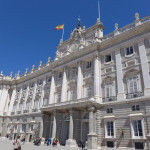



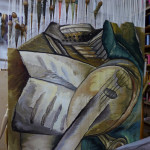


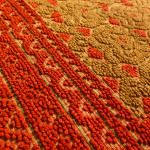




























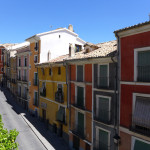







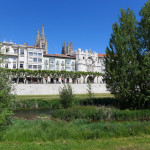


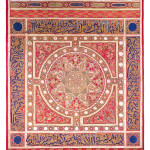

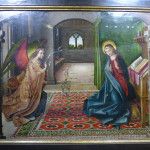


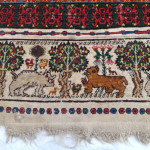







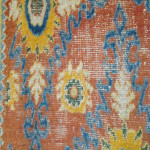














Comments [0] Sign in to comment